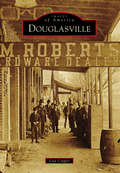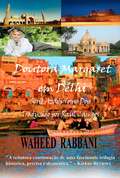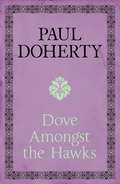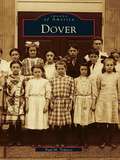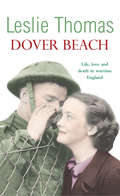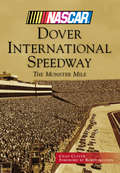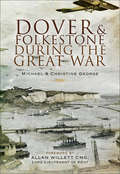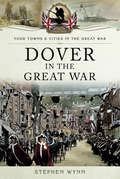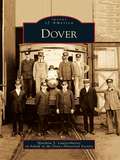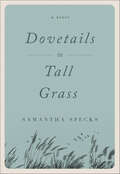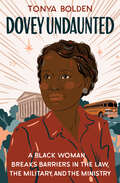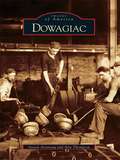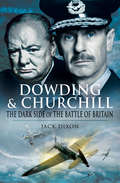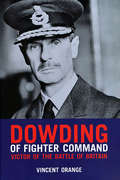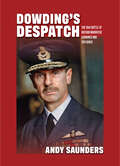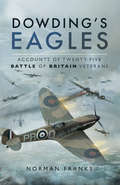- Table View
- List View
Douglass: Autobiographies
by Frederick Douglass Henry Louis Gates Jr.Frederick Douglass, born a slave, educated himself, escaped, and made himself one of the greatest leaders in American history. His brilliant anti-slavery speeches were so fiercely intelligent, and so startlingly eloquent, that many people didn't believe he had been a slave. To prove them wrong, Douglass decided to write his own story. His autobiographical narratives stunned the world, and have shocked, moved, and inspired readers ever since. Here, complete for the first time in one authoritative volume, are the three powerful and gripping stories, now recognized as classics of American writing. Fascinating firsthand accounts of slavery and abolitionism, John Brown and Abraham Lincoln, the Civil War, Reconstruction, and the emerging struggle for civil rights, they are above all the inspiring story of a self-made American.
Douglasville (Images of America)
by Lisa CooperThe formation of Douglasville coincided when New South ideals were reshaping villages into railroad towns across the South during Reconstruction. In 1875, business and political leaders worked from the ground up to provide Douglasville with each component of a New South town, including a railroad, cotton mill, hotel, bank, and a commercial district. Today, the central business district is listed in the National Register of Historic Places and presents a snapshot regarding how the town fathers actualized their vision of industry and enterprise. Douglasville's founders would be pleased if they visited the town they created 138 years ago. It has entered the 21st century as a vibrant city with a thriving historic district, as well as a destination for businesses ranging from Google to the American Red Cross.
Doutora Margaret em Délhi
by Waheed Rabbani Raul CamposDOUTORA MARGARET EM DÉLHI Doutora Margaret em Délhi é o Tomo Dois da Série Azadi e é a continuação do Tomo Um: Baú Marítimo da Doutora Margaret. Esse romance de ficção histórica continua com a viagem de Maragret após sua participação com seu marido canadense na Guerra de Crimeia de 1854. A Doutora Margaret viaja sozinha para a Índia para estar com seus pais na Missão Presbiteriana Americana em Fatehgarh, e depois para seu emprego num hospital em Deli. Os eventos que antecederam o Motim/Rebelião Indiana que ocorreu em 1857 afetam profundamente as vidas não só da Margaret, mas também daqueles que amam ela e outros que a desejam mal. Envolvido na confusão está também o Cipaio Sharif Khan Bhadur, avô do Doutor Wallidad, um médico americano. Essa série descreve os eventos emocionantes e o tumulto que inflamaram a Índia de 1857 até 1947, e culminaram com sua independência. Esses eventos abraçam as personagens dessa história naquela época, e a vida de seus descendentes na década de 1960.
Dove Amongst the Hawks: A gripping historical epic of the Wars of the Roses
by Paul DohertyWith secrets around every corner, can the truth ever be uncovered?The turbulent times of the Wars of the Roses are explored in Paul Doherty's unputdownable novel, Dove Amongst the Hawks. Perfect for fans of C.J Sansom and Susanna Gregory.A physician in London during the Wars of the Roses, Dr Luke Chichele becomes well acquainted with royalty. Part of a plot instigated by the Pope, he is tasked with investigating the death of King Henry VI in the Tower of London. Was it suicide or murder? The Pope wants to prove Henry as worthy of beatification, while the new King, Edward IV, claims he died witless and incapable. The closer Luke comes to the truth, the more his life falls into danger...What readers are saying about Paul Doherty:'Thoroughly enjoyable story written in Doherty's inimitable style... a new angle on the mysterious death of a king''I would read a cornflake box if Paul Doherty had written it''Five stars'
Dove Amongst the Hawks: A gripping historical epic of the Wars of the Roses
by Paul DohertyWith secrets around every corner, can the truth ever be uncovered?The turbulent times of the Wars of the Roses are explored in Paul Doherty's unputdownable novel, Dove Amongst the Hawks. Perfect for fans of C.J Sansom and Susanna Gregory.A physician in London during the Wars of the Roses, Dr Luke Chichele becomes well acquainted with royalty. Part of a plot instigated by the Pope, he is tasked with investigating the death of King Henry VI in the Tower of London. Was it suicide or murder? The Pope wants to prove Henry as worthy of beatification, while the new King, Edward IV, claims he died witless and incapable. The closer Luke comes to the truth, the more his life falls into danger...What readers are saying about Paul Doherty:'Thoroughly enjoyable story written in Doherty's inimitable style... a new angle on the mysterious death of a king''I would read a cornflake box if Paul Doherty had written it''Five stars'
Dove Song
by Kristine L. FranklinWhen eleven-year-old Bobbie Lynn's father is reported missing in action in Vietnam, she and her thirteen-year-old brother must learn to cope with their own despair, as well as their mother's breakdown.
Dove and Sword: A Novel of Joan of Arc
by Nancy GardenThis is a story of the Hundred Years' War and its great heroine, Joan of Arc. When Joan sets out to lead an army against the British, her friend Gabrielle stays loyally by her side until the wrenching finish.
Dove and Sword: A Novel of Joan of Arc
by Nancy GardenA young girl follows Joan of Arc into battle in this gripping historical novel. Having grown up in the quiet French village of Domremy, eleven-year-old Gabrielle can’t resist the promise of experiencing something new. So when her friend Jeannette d’Arc claims to have been chosen by God to restore the French king to the throne and end the war that has raged too long, Gabrielle joins her on her crusade. Disguised as a boy, young Gabrielle uses her skills as a healer to help those fighting for the cause. At first, she expects to find glorious adventure, but experiencing the horrors of war, she must come to terms with the true cost of courage in the face of the unthinkable. This “gripping, gritty tale” is a unique perspective on the heroine of the Hundred Years’ War who was later canonized as a Roman Catholic saint (Kirkus Reviews).
Dover
by Donna P. HearnThrough the years, Dover's landscape has been greatly shaped by the contributions of its many influential residents. Upon his arrival, Richard Sackett, the first English settler in eastern Dutchess County, gazed at the soaring hillsides and gave the town its current name. Dover's most important and pivotal event occurred in 1731, when it hosted representatives at an interstate boundary conference. That indenture signing set the judicial line between the colony of Connecticut and the province of New York. After 1845, the railroad exported iron and brought artists like Asher Durand, whose painting of Dover's plains hangs today in the Smithsonian American Art Museum. With the train came tourists and painters, who were drawn to the sites they saw in Durand's works. In the 20th century, the area changed again as old farms disappeared and new industry moved into town. While the community sent men to war and compassionately housed the mentally ill, the Dover Drag Strip made history as one of the first big drag racing tracks.
Dover
by George Laurie Stanley SchoonmakerWhen Dover was settled in 1722, the only inhabitants of this northern New Jersey wilderness were Native Americans. The early iron forges along the mighty Rockaway River were soon developed, followed by the Morris Canal; it was, however, the coming of the railroad in 1848 that truly transformed the small village. Two hundred and seventy-five years later, Dover is still evolving. In Dover, the town's colorful and diverse past is chronicled through over 200 vintage, many neverbefore-seen photographs, including images of the historic Morris Canal, the majestic churches, theaters, schools, factories, and downtown businesses. See how Blackwell Street looked 100 years ago, and look at sights long gone, such as the Dover speedway, the trolleys, and early automobiles. Most importantly, see the faces of Dover's people, both past and present, that have enriched and molded its past.
Dover (Images of America)
by Paul H. TedescoOriginally part of the Dedham Grant of 1635, Dover, Massachusetts, became Dedham's Fourth Precinct in 1729 and the Springfield Parish of Dedham in 1748. When the Commonwealth incorporated it in 1836, Dover's economy was based on farming and grazing. Several companies, including the E.F. Hodgson Company and the Harvard Apparatus Company, successfully manufactured portable houses and medical instruments in Dover. However, they eventually left, as Dover remained agriculturally based. By 1896, Dover had become a suburban community. From 1900 to 1914, wealthy Bostonians--many of them members of the Norfolk Hunt Club--built at least eighteen spacious country estates in Dover, far from the noise and hubbub of the city. Population grew slowly after World War I, but in 1945, the town increased in numbers, as veterans returned from World War II and others saw the convenience of commuting to work in Boston while living in a pastoral environment. Once the home of Sen. Leverett Saltonstall, Gov. Francis Sargent, and benefactress Amelia Peabody, Dover today is an elegant country town, a mixture of estates, open fields, forests, and family neighborhoods.
Dover Beach
by Leslie ThomasSummer 1940. The evacuation of Dunkirk proves that the British can rise to a challenge, even against seemingly insurmountable odds. But now the soldiers walk the streets of Dover, even wandering through Woolworths store, and take weary turns on the town's skating rink.Life, despite the threat of invasion and the reality of bombing, must go on and people must take comfort where they find it. Toby Hendry, a fighter pilot, is awaiting orders when he meets Giselle, a young Frenchwoman who took the chance to flee occupied France with the English troops. Their love affair feels like a summer idyll, but can it withstand the forces of war?Meanwhile, reserve naval commander Paul Instow has been called up to fight in a war for which he feels too old. Distracting him from his worries is Molly, a young Dover prostitute. Their relationship is tender and happy, but is this a love born from desperation or could it be something more permanent?And then there are Harold, Spots and Boot, three boys desperate to fight the German invaders, armed only with catapults and a stolen Bren gun...In Dover Beach Thomas chronicles the lives and loves of ordinary people in besiged Britain during these tense, but curiously elated days.
Dover International Speedway: The Monster Mile
by Chad Culver Bobby AllisonIn the fertile farmlands of Delaware, there is a monster--a one-mile, concrete oval that has earned a reputation for being one of the toughest NASCAR® tracks since its first race in 1969. Built upon a farmer's field and airstrip, Dover International Speedway has a story filled with dreams and determination. From Richard Petty's first win at the speedway in 1969 through today's modern NASCAR heroes, "The Monster Mile" has witnessed some of racing's most memorable moments and continues to provide some of the best racing in NASCAR to this day. Many rare images have been gathered to provide a never-before-seen look at this historic speedway. Take a journey through time on one of the toughest, fastest, and most unique tracks ever built.
Dover and Folkestone During the Great War
by Michael George Christine GeorgeFor centuries the south coast of Kent in particular the ports of Dover and Folkestone—have been Englands front line, as her enemies have planned invasions and launched attacks from just across the Channel. During the Great War of 1914–1918 these two towns were again vulnerable to enemy action, and they played a vital role in war effort. As this well-researched and highly illustrated book shows, the people of the Channel Ports suffered from bombardment by air and sea. They also played a significant role in the experience of the men who fought in the Great War. For the humble soldier, this stretch of coastline had a personal meaning—it represented Blighty. It might be the last thing the departing Tommy would see of his country and, for a soldier returning wounded or on leave, the White Cliffs on the horizon were his first glimpse of home.
Dover in the Great War (Your Towns & Cities in the Great War)
by Stephen WynnSituated on the south coast of England, geographically and strategically, Dover more than played its part in the First World War. It was from its harbor that the many vessels of the Dover Patrol set about preventing German ships from using the English Channel. It was undoubtedly one of the most important Royal Naval units that Britain had during the First World War.Because of its important defensive roll, Dover was identified as a legitimate and relevant target by the German authorities. As a result, German Zeppelin's and Gotha aircraft subjected Dover to 113 aerial attacks, dropping 185 bombs in the process. The first of these raids took place on Christmas Eve, 1914; this was also the first time a German bomb had been dropped on British soil. The last raid was on 24 August 1918, in which twenty adults and three children were killed.The local residents who, for whatever reason, were unable to enlist in the military during the war, but who still felt the desire and obligation to serve their King and country, were able to do so in organizations such as the Dover Volunteer Training Corps. Most towns had similar units, and their members carried out some sterling work on the Home Front.By the end of the war, Dover and its people had sustained through testing and difficult times. Like every community throughout the nation, they had paid a heavy price. They had been as close to the war as it was possible to be, without actually being on the Front Line. Ships had sailed from its harbour to engage the enemy, and wounded soldiers had returned to the same harbour. Its men had gone of to fight in the war and, sadly, 721 of them never came back.
Dover: Proceedings Of The One Hundred And Twenty-fifth Anniversary Of The Incorporation Of The Town Of Dover, Massachusetts, Wednesday, July 7, 1909 (classic Reprint) (Images of America)
by Dover Historical Society Matthew S. LautzenheiserIn 1807, Christian Deardorff and Jesse Slingluff set out for the Ohio frontier. Before leaving, the men laid out the plat of a village that would sit at the banks of the Tuscarawas River. Over the next 10 years as Deardorff toiled away in his bachelor cabin, he held on to the dream of building his vision. The original plat map the two men devised contained 256 lots with land set aside for churches, schools, and a spacious downtown square. Today, over 200 years after Slingluff and Deardorff filed their plat at Zanesville, Dover continues to reflect their vision of a pleasant little town situated on the Tuscarawas River.
Doves Of Venus
by Olivia ManningPretty, brave and eighteen, Ellie has come to London in search of adventure. She soon finds it in Quintin Bellot, the handsome but tired dilettante who finds her a job in fashionable Chelsea. But Quintin, the seducer of one dove, is also the husband of another. And Petta, his once beautiful wife, is fighting back age as fiercely as Ellie is plunging into it.
Dovetails in Tall Grass: A Novel
by Samantha SpecksAs war overtakes the frontier, Emma’s family farmstead is attacked by Dakota-Sioux warriors; on that same prairie, Oenikika desperately tries to hold on to her calling as a healer and follow the orders of her father, Chief Little Crow. When the war is over and revenge-fueled war trials begin, each young woman is faced with an impossible choice. In a swiftly changing world, both Emma and Oenikika must look deep within and fight for the truth of their convictions—even as horror and injustice unfolds all around them. Inspired by the true story of the thirty-eight Dakota-Sioux men hanged in Minnesota in 1862—the largest mass execution in US history—Dovetails in Tall Grass is a powerful tale of two young women connected by the fate of one man.
Dovey Undaunted: A Black Woman Breaks Barriers in the Law, the Military, and the Ministry
by Tonya BoldenCoretta Scott King Honor–winning author Tonya Bolden chronicles the life of an intrepid lawyer and civil rights pioneer. Dovey Johnson Roundtree was most famous for her successful defense of an indigent Black man accused of the murder of Mary Pinchot Meyer, a prominent white Washington, DC, socialite, in 1965. Despite her triumph in this high-profile case, Roundtree continued to represent the poor and the underserved. She was the first lawyer to bring a bus desegregation case before the Interstate Commerce Commission, clinching the ruling that enabled Robert F. Kennedy to enforce bus integration. She was also among the first Black women to enter the Women’s Army Auxiliary Corps, and was one of the first ordained female ministers in the African Methodist Episcopal Church. Tracing Roundtree’s life from her childhood in Jim Crow North Carolina through her adulthood, Tonya Bolden illuminates a little-known figure in American history who believed the law should serve the people, and places her firmly in the context of twentieth-century civil rights and African American culture.
Dowagiac
by Ann Thompson Steven ArseneauThe story of Dowagiac's first 100 years may ring familiar to other small cities across the United States. After Dowagiac was established on a railroad line in 1848, new settlers arrived and had the opportunity to establish large-scale factories in the young village. This growth would last for afull century, fueled by the Round Oak Stove Company and other manufacturers in the city. Because of its manufacturing base, immigrants moved to Dowagiac, and the small city enjoyed strong business and manufacturing districts, solid educational institutions, and a vibrant social life. Surrounding lakes provided one venue for entertainment, while downtown Dowagiac offered theaters and fairs. This book documents and celebrates the history of Dowagiac with over 200 photographs from the collection of the Museum at Southwestern Michigan College.
Dowding & Churchill: The Dark Side of the Battle of Britain
by Jack DixonA WWII historian shines a light on an unsung hero of the Battle of Britain and reveals the conspiracy that led to his undignified dismissal.From 1936 to 1940, Air Chief Marshal Sir Hugh Dowding built Britain’s cutting edge defensive force, Fighter Command. Thanks to his foresight, Fighter Command was the only military arm prepared for battle when war was declared against Germany. Dowding’s leadership of Fighter Command was crucial to achieving victory in the Battle of Britain—one of the decisive battles of Western Civilization.Though the importance of the Battle of Britain was recognized at the time, Dowding was relieved of his command shortly afterward—and shuffled into retirement without recognition. This book reveals that this was the result of a shabby conspiracy by fellow officers. In March 1941, the Air Ministry published a brief account of the battle that made no mention of Dowding.Churchill was furiously indignant. But in November 1940 he had acquiesced in Dowding’s removal. Why? And what are the factors that led to Dowding’s dismissal in the first place? In this thought-provoking and authoritative book Jack Dixon answers these questions and explains Dowding’s true greatness.
Dowding of Fighter Command: Victor of the Battle of Britain
by Vincent OrangeAn extensive biography of the life and distinguished military career of the Scottish air chief marshal. Making full use of archival sources, studies by other scholars, and information provided by family members, Vincent Orange has completed the first biography of Air Chief Marshal Sir Hugh Dowding to cover his entire life. Soldier, pilot, wireless pioneer, squadron commander, spiritualist, champion skier, &“Stuffy&” Dowding is perhaps best known as the creator of the first radar-based air defense system and his no less remarkable management of such throughout the Battle of Britain. Dowding served in &“delightful and dangerous Iraq,&” helped to pacify unrest in the Holy Land, was involved in the R.101 airship disaster, and oversaw the creation of Britain&’s first eight-gun monoplanes, the Hurricane and Spitfire. Controversially dismissed from Fighter Command and refused the R.A.F.&’s highest rank, he nevertheless became the first airman elevated to the peerage since Trenchard. Westminster Abbey was packed for his memorial service in March 1970 with more than 46 air marshals in attendance; and in 1988, H.M. the Queen Mother unveiled a statue in his honor. With his expert eye, respected historian Orange has analyzed and evaluated every episode of Dowding&’s exceptional career to produce the definitive biography.
Dowding's Despatch: The 1941 Battle of Britain Narrative Examined and Explained
by Andy SaundersIn September 1946, the London Gazette published a despatch from Air Chief Marshal Sir Hugh C T Dowding that was titled simply: The Battle of Britain. Written and submitted to the Air Ministry in 1941, this document became the very framework for the accepted Battle of Britain narrative which has been established across the following eighty years. Set out by the leader of the ‘Few’ himself, its authoritative tone could surely be considered a definitive outline of the battle, how it was fought and the eventual outcome. It even retrospectively set the dates for the commencement and conclusion of the campaign. In this work, Andy Saunders takes a critical look at Dowding’s despatch and analyses the facts and details contained in that important document. He also puts ‘flesh on the bones’ of the matters that the former commander-in-chief of RAF Fighter Command outlines, adding intriguing historical detail and perspective to the 1946 publication. Additionally, Andy looks at the behind-the-scenes machinations at the highest levels of government and Air Ministry before the despatch finally saw the light of day. As a historical document, Dowding’s London Gazette despatch is worthy of the critical analysis and factual expansion which the author provides in what is a uniquely different look at the Battle of Britain, with illustrations throughout.
Dowding's Eagles: Accounts of Twenty-Five Battle of Britain Veterans
by Norman FranksTwenty-five veteran airmen share stories of their experiences during World War II’s Battle of Britain in this unique history.The Battle of Britain fought by The Few, as Churchill famously called them, will remain a legendary feat of arms for centuries to come. Sadly, there remain only a handful today who can tell their stories so this collection of personal accounts is extremely timely.The Author has over the years gathered the stories of twenty-five survivors and in Dowding’s Eagles he brings these stirring stories together. Each account describes the actions and impressions of the individuals who fought lonely battles against a numerically superior enemy. The odds were stacked against The Few.Over 500 pilots were killed in action during the summer of 1940, and this book is as much about those who gave their lives for their country as those who risked everything but managed to survive.Together with photographs of the men and their aircraft, this is an inspiring book.
Down Along with That Devil's Bones: A Reckoning with Monuments, Memory, and the Legacy of White Supremacy
by Connor Towne O'Neill&“We can no longer see ourselves as minor spectators or weary watchers of history after finishing this astonishing work of nonfiction.&” —Kiese Laymon, author of Heavy In Down Along with That Devil&’s Bones, journalist Connor Towne O&’Neill takes a deep dive into American history, exposing the still-raging battles over monuments dedicated to one of the most notorious Confederate generals, Nathan Bedford Forrest. Through the lens of these conflicts, O&’Neill examines the legacy of white supremacy in America, in a sobering and fascinating work sure to resonate with readers of Tony Horwitz, Timothy B. Tyson, and Robin DiAngelo. When O&’Neill first moved to Alabama, as a white Northerner, he felt somewhat removed from the racism Confederate monuments represented. Then one day in Selma, he stumbled across a group of citizens protecting a monument to Forrest, the officer who became the first Grand Wizard of the Ku Klux Klan and whom William Tecumseh Sherman referred to as &“that devil.&” O&’Neill sets off to visit other disputed memorials to Forrest across the South, talking with men and women who believe they are protecting their heritage, and those who have a different view of the man&’s poisonous history. O&’Neill&’s reporting and thoughtful, deeply personal analysis make it clear that white supremacy is not a regional affliction but is in fact coded into the DNA of the entire country. Down Along with That Devil&’s Bones presents an important and eye-opening account of how we got from Appomattox to Charlottesville, and where, if we can truly understand and transcend our past, we could be headed next.

